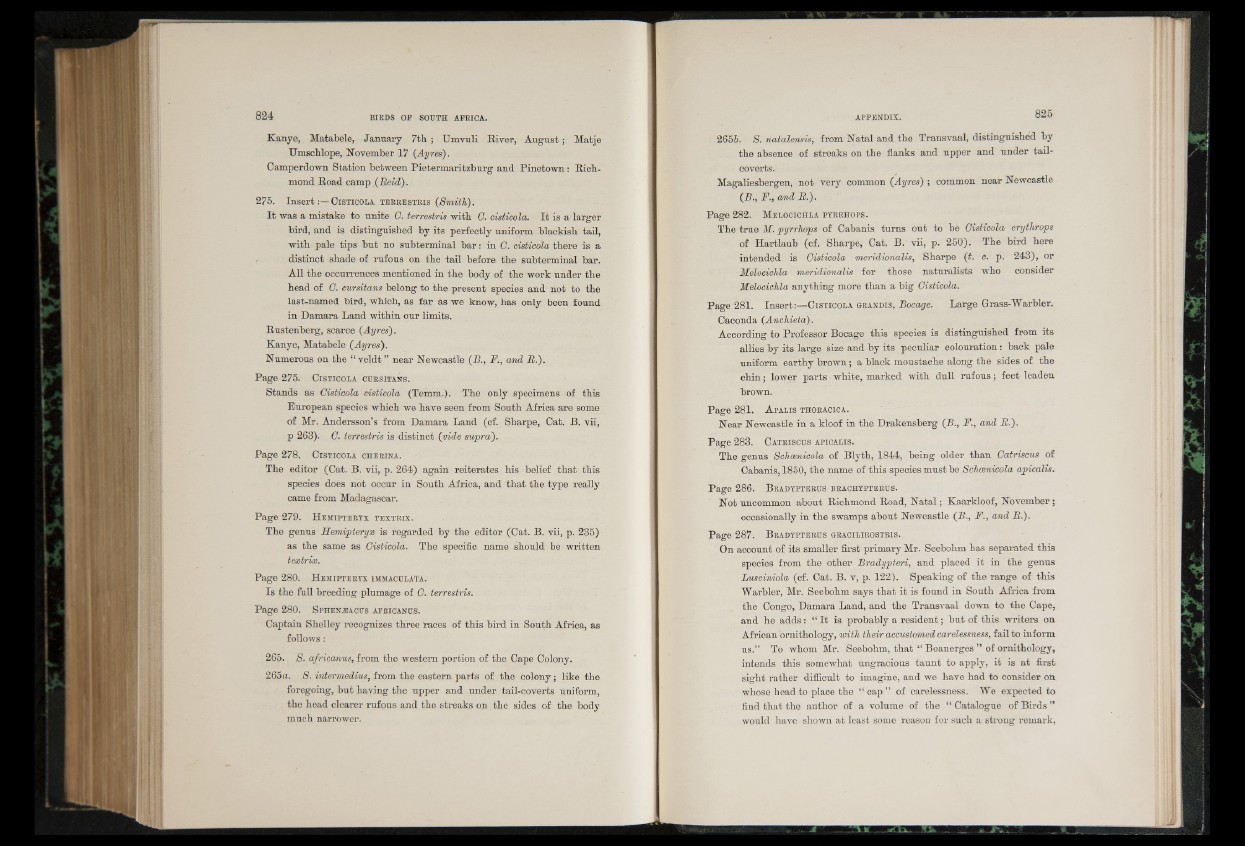
Kanye, Matabele, January 7th ; Umvuli River, A u g u s t; Matje
Umschlope, November 17 (Ayres).
Camperdown Station between Pietermaritzburg and Pinetown : Richmond
Road camp (Reid).
275. I n s e r t C i s t ic o l a t b r r e s t r i s (Smith).
I t was a mistake to unite C. terrestris with G. cisticola,. I t is a larger
bird, and is distinguished by its perfectly uniform blackish tail,
with pale tips but no subterminal b a r : in 0. cisticola there is a
distinct shade of rufous on the tail before the subterminal bar.
All the occurrences mentioned in the body of the work under the
head of G. cursitans belong to the present species and not to the
last-named bird, which, as far as we know, has only been found
in Damara Land within our limits.
Rustenberg, scarce (Ayres).
Kanye, Matabele (Ayres).
Numerous on the “ v e ld t” near Newcastle (B., F., and B.).
Page 275. C i s t i c o l a c u r s i t a n s .
Stands as Cisticola cisticola (Temm.). The only specimens of this
European species which we have seen from South Africa are some
of Mr. AndersBon’s from Damara Land (cf. Sharpe, Cat. B. vii,
p 263). G. terrestris is distinct (vide supra).
Page 278, C i s t i c o l a c h e r in a .
The editor (Cat. B. vii, p. 264) again reiterates his belief th a t this
species does not occur in South Africa, and that the type really
came from Madagascar.
Page 279. H em ip t e b tx t b x t r i x .
The genus Hemipteryx is regarded by the editor (Cat. B. vii, p. 235)
as the same as Cisticola. The specific name should be written
textrix.
Page 2 8 0 . H em ip te ry x im m a cu la ta .
Is the full breeding plumage of G. terrestris.
Page 2 8 0 . S p h e n jia c u s a f r i c a n u s .
Captain Shelley recognizes three races of this bird in South Africa, as
follows:
265. S. africanus, from the western portion of the Cape Colony.
265a. S. intermedins, from the eastern parts of the colony; like the
foregoing, but having the upper and under tail-coverts uniform,
the head clearer rufous and the streaks on the sides of the body
much narrower.
2656. S. natalensis, from Natal and the Transvaal, distinguished by
the absence of streaks on the flanks and upper and under tail-
coverts.
Magaliesbergen, not very common (Ayres) ; common near Newcastle
(B., F., and B.).
Page 282. M e l o c i c h l a p y r rh o p s .
The true M. pyrrhops of Cabanis turns out to be Cisticola erythrops
of Hartlaub (cf. Sharpe, Cat. B. vii, p. 250). The bird here
intended is Cisticola meridionalis, Sharpe (t. c. p. 243), or
Melocichla meridionalis for those naturalists who consider
Melocichla anything more than a big Gisticola.
Page 281. Insert:—C i s t i c o l a g r a n d is , Bocage. Large Grass-Warbler.
Caconda (Anchieta).
According to Professor Bocage this species is distinguished from its
allies by its large size and by its peculiar colouration: back pale
uniform earthy brown; a black moustache along the sides of the
ch in ; lower parts white, marked with dull rufous; feet leaden
brown.
Page 281. A p a l is th o r a c i c a .
Near Newcastle in a kloof in the Drakensberg (B., F., and B.).
Page 283. C a t r i s c u s a p ic a lis .
The genus Schcenicola of Blyth, 1844, heing older than Catriscus of
Cabanis, 1850, the name of this species must be Schcenicola apicalis.
Page 286. B r a d y p t e r u s b r a c h y p t e r u s .
Not uncommon about Richmond Road, N a ta l; Kaarkloof, November ;
occasionally in the swamps about Newcastle (B., F., and B.).
Page 287. B r a d y p t e r u s g r a c i l i r o s t r i s .
On account of its smaller first primary Mr. Seebohm has separated this
species from the other Bradypteri, and placed it in the genus
Lusciniola (cf. Cat. B. v, p. 122). Speaking of the range of this
Warbler, Mr. Seebohm says th a t it is found in South Africa from
the Congo, Damara Land, and the Transvaal down to the Cape,
and he ad d s: “ I t is probably a resident; but of this writers on
African ornithology, with their accustomed carelessness, fail to inform
us.” To whom Mr. Seebohm, th a t “ Boanerges ” of ornithology,
intends this somewhat ungracious taunt to apply, it is a t first
sight rather difficult to imagine, and we have had to consider on
whose head to place the “ cap ” of carelessness. We expected to
find th a t the author of a volume of the “ Catalogue of Birds ”
would have shown at least some reason for such a strong remark,